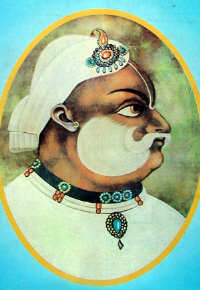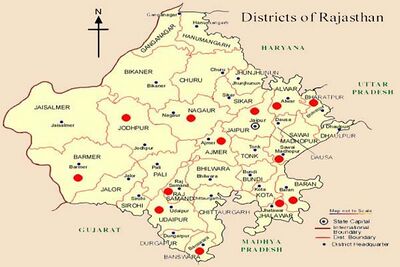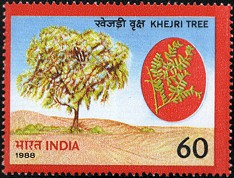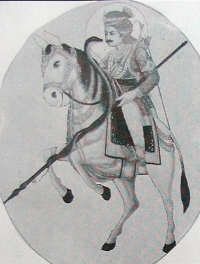Rajasthan

Rajasthan (राजस्थान) is the largest state of the Republic of India in terms of area. It borders Pakistan to the west, Gujarat to the southwest, Madhya Pradesh to the southeast, Uttar Pradesh and Haryana to the northeast and Punjab to the north. Rajasthan covers an area of 342,239 km².
Origin
Namesake
- Rajasthan = Rajasthaniyas (राजस्थानीय) (L.2). Rajasthaniyas (राजस्थानीय) (L.2) is mentioned in Nagardhan Plates Of Svamiraja : (Kalachuri) Year 322 (=573 AD) as an officer.....Swamiraja's brother Nannarâja (नन्नराज) (L.2), who meditates on him, honours all his (officers) such as Rajasthaniyas (राजस्थानीय) (L.2), Uparikas (उपरिक) (L.3), Dandapashikas (दाण्डपाशिक) (L.3), Chatas (चाट) (L.3), Bhatas (भट) (L.3), Dutasampreshanikas (दूतसम्प्रेषणिक) (L.3) and Drangikas (द्राङ्गिक) (L.3) (p.616).[1]
Districts and Tahsils of Rajasthan
Geography


The state capital is Jaipur. Geographical features include the Thar Desert in western Rajasthan and the termination of the Ghaggar River. One of the world's oldest mountain ranges, the Aravalli Range, cradles the only hill station of Rajasthan, Mount Abu, and its world famous Dilwara Temples. Eastern Rajasthan has two national tiger reserves, Ranthambore and Sariska, as well as Keoladeo National Park near Bharatpur, famous for its bird life.
Rajasthan was earlier called Rajputana (state of Rajputs) after the ruling class of Rajputs. Rajput clans rose to prominence in the 6th century, establishing kingdoms in Rajasthan and across northern India. A number of Rajput states became tributaries to the Delhi Sultanate and Mughal Empire during those empires' peak of expansion. As these empires weakened, the Rajputs reasserted their independence. With the decline of the Mughal Empire in the 18th century, Rajputana become more and more independent. The Rajput kings concluded treaties with the British in the early 19th century, accepting British sovereignty. Ajmer became a province of British India, while the autonomous Rajput states and a few non-Rajput states (Tonk, Bharatpur, and Dholpur) were organized into the Rajputana Agency. Bharatpur and Dholpur were Jat states.
The Rajputana name of Rajasthan came into existence in the rule of Akbar but it did not get much publicity. Rajputana name come into use after Col James Tod wrote his book ‘Rajasthan’ at the time of British rule.
राजस्थान : एक परिचय
राजस्थान भारत वर्ष के पश्चिम भाग में अवस्थित है जो प्राचीन काल से विख्यात रहा है। तब इस प्रदेश में कई इकाईयाँ सम्मिलित थी जो अलग-अलग नाम से सम्बोधित की जाती थी। उदाहरण के लिए जयपुर राज्य का उत्तरी भाग मध्यदेश का हिस्सा था तो दक्षिणी भाग सपादलक्ष कहलाता था। अलवर राज्य का उत्तरी भाग कुरुदेश का हिस्सा था तो भरतपुर, धोलपुर, करौली राज्य शूरसेन देश में सम्मिलित थे। मेवाड़ जहाँ शिवि जनपद का हिस्सा था वहाँ डूंगरपुर-बांसवाड़ा वार्गट (वागड़) के नाम से जाने जाते थे। इसी प्रकार जैसलमेर राज्य के अधिकांश भाग बल्लदेश में सम्मिलित थे तो जोधपुर मरुदेश के नाम से जाना जाता था। बीकानेर राज्य तथा जोधपुर का उत्तरी भाग जांगल देश कहलाता था तो दक्षिणी भाग गुर्जरत्रा (गुजरात) के नाम से पुकारा जाता था। इसी प्रकार प्रतापगढ़, झालावाड़ तथा टोंक का अधिकांश भाग मालवादेश के अधीन था। [2] हर्ष शिलालेख से यह भी ज्ञात होता है कि तंत्रपाल नामक प्रतिहारों का दूत जब चौहान नरेश वाक्पति से मिलने आया तो वह अनंतगोचर आया। इतिहासकार अनंतगोचर को हर्ष के आस-पास का क्षेत्र मानते हैं। (रतन लाल मिश्र:शेखावाटी का नवीन इतिहास, मंडावा, 1998, पृ.37 -38) वर्त्तमान शेखावाटी के क्षेत्र को अनंतगोचर कह सकते हैं।
इतिहासकार रतन लाल मिश्र मानते हैं कि राजस्थान में राजपूतकुलों के शासन के पूर्व इस क्षेत्र में जाट जाति उपस्थित थी जिसका शासन गणराज्य की पंचायत पद्धति पर चलता था। [3] ठाकुर देशराज ने जाट इतिहास में अनेक जाट गणराज्यों का वर्णन किया है। [4] डॉ पेमा राम ने 'राजस्थान के जाटों का इतिहास' पुस्तक में राजस्थान के जाटों के गणराज्य एवं उनका पतन तथा जाट जनपदों की प्रशासनिक व्यवस्था पर विस्तार से प्रकाश डाला है। [5]
बाद में जब राजपूतों ने इस राज्य के विविध भागों पर अपना आधिपत्य जमा लिया तो उन भागों का नामकरण अपने-अपने वंश अथवा स्थान के अनुरुप कर दिया। ये राज्य उदयपुर, डूंगरपुर, बांसवाड़, प्रतापगढ़, जोधपुर, बीकानेर, किशनगढ़, सिरोही, कोटा, बूंदी, जयपुर, अलवर, करौली और झालावाड़ थे। भरतपुर एवं धोलपुर में जाटों का राज्य रहा तथा टोंक में मुस्लिम राज्य था।[6] [7]
इन राज्यों के नामों के साथ-साथ इनके कुछ भू-भागों को स्थानीय एवं भौगोलिक विशेषताओं के परिचायक नामों से भी पुकारा जाता है। ढ़ूंढ़ नदी के निकटवर्ती भू-भाग को ढ़ूंढ़ाड़ (जयपुर) कहते हैं। मेव तथा मेद जातियों के नाम से अलवर को मेवात तथा उदयपुर को मेवाड़ कहा जाता है। मरु भाग के अन्तर्गत रेगिस्तानी भाग को मारवाड़ भी कहते हैं। डूंगरपुर तथा उदयपुर के दक्षिणी भाग में प्राचीन ५६ गांवों के समूह को "छप्पन" नाम से जानते हैं। माही नदी के तटीय भू-भाग को कोयल तथा अजमेर के पास वाले कुछ पठारी भाग को ऊपरमाल की संज्ञा दी गई है। [8] [9]
राजस्थान को आजादी से पहले राजपूताना नाम से पुकारा जाता था जो यह भ्रम उत्पन्न करता था कि यह राजपूत बहुल प्रदेश है। हकीकत में ऐसा नहीं है। राजपूताना नाम की बुनियाद अकबर के समय में उनके अच्छे संबंद होने के कारण पड़ी परन्तु प्रचार नहीं हुआ। राजपूताना नाम का प्रचार कर्नल टाड की 'राजस्थान' के लिखे जाने के पश्चात अंग्रेज सरकार के काल में हुआ। [10] अंग्रेजों के शासनकाल में राजस्थान के विभिन्न इकाइयों का एकीकरण कर इसका राजपूताना नाम दिया गया, कारण कि उपर्युक्त वर्णित अधिकांश राज्यों में राजपूतों का शासन था। ऐसा भी कहा जाता है कि सबसे पहले राजपूताना नाम का प्रयोग जार्ज टामस ने किया। राजपूताना के बाद इस राज्य को राजस्थान नाम दिया गया। प्रसिद्ध इतिहास लेखक कर्नल टॉड ने इस राज्य का नाम "रायस्थान" रखा क्योंकि स्थानीय साहित्य एवं बोलचाल में राजाओं के निवास के प्रान्त को रायस्थान कहते थे। इसी का संस्कृत रुप राजस्थान बना। हर्ष कालीन प्रान्तपति, जो इस भाग की इकाई का शासन करते थे, राजस्थानीय कहलाते थे। सातवीं शताब्दी से जब इस प्रान्त के भाग राजपूत नरेशों के आधीन होते गये तो उन्होंने पूर्व प्रचलित अधिकारियों के पद के अनुरुप इस भाग को राजस्थान की संज्ञा दी जिसे स्थानीय साहित्य में रायस्थान कहते थे। जब भारत स्वतंत्र हुआ तथा कई राज्यों के नाम पुन: परिनिष्ठित किये गये तो इस राज्य का भी चिर प्रतिष्ठित नाम राजस्थान स्वीकार कर लिया गया। [11]
राजस्थान में जाटों की संख्या प्रायः सभी जातियों से अधिक है, जो कि कुल आबादी का 9.28 % है। सन् 1931 की जनगणना रिपोर्ट के अनुसार 1042152 जनसंख्या जाटों की थी। किसी-किसी रियासत में उनकी आबादी कुल आबादी का 23 प्रतिशत तक थी। राजपूतों की आबादी उस समय राजस्थान में केवल 633830 थी। जो कुल आबादी का 5.65 % थी। राजस्थान में जाट राजपूतों की दुगुनी संख्या में थे और उनसे पहले से वहां बसे हुए थे।[12]
Jat population in Rajasthan
The exact Jat population in Rajasthan at present is not available as there is no caste wise census after 1931 in India. We can take 1931 Jat population as an indication of the proportion of it to the other castes. It can also be extrapolated on the ration of 2001 census and 1931 census, which can give approximate Jat population.
The total population of India in 1931 was 27.09 crore and in 2001 was 102.7 crore. Thus there is an increase of 3.681 times. On this basis the present Jat population in Rajasthan must be 3.681 times 1142025 = 4203800. Thus we can say population of Jats in Rajasthan is 4203800.
Jat population 1931
Thakur Deshraj has given an analysis of Jat population in Rajasthan as on 1931. Rajasthan was called Rajputana prior to independence. As per 1931 census the population of Jats in Rajasthan was as under:
Rajputana…………….1042152
Ajmer-Merwara………….30000
Bisnoi Jats………………69873
Total Jat population…. 1142025
The population of jats in then princely states where they were in sizable proportion was as under:
Bharatpur state…………72378
Bikaner state………….215947
Jaipur state……………313609
Marwar sate…………..283933
Bisnoi jats mainly inhabited the areas of Bikaner, Jaipur, Bharatpur, Marwar, Kishangarh and Mewar and their combined population was 69873.
Highest Jat density areas
Thakur Deshraj has mentioned that the maximum density of Jats was in following tehsils in each princely state as under:
- Bikaner state – All tehsils
- Kishangarh state – Arai, Kishangarh, Rupnagar and Sarwar
Some statistics
- The population of Jats in Rajasthan was more than all other castes, which was 9.28 % of total population.
- In some of princely states their population was as high as 23 % of total population.
- The population of Rajputs in the state was 633830, which was 5.65 % of total population.
- The total Jat population including Bisnois was double of Rajputs.
- Jats were the inhabitants of Rajasthan from much earlier periods.
Jat rulers in Rajasthan
- See main article मध्यकालीन राजस्थान में जाट जनपद
According to Dr Naval Viyogi, Rajasthan was sometimes the greatest centre of Naga ruler. Present Tonk town was centre of Naga rulers and is called in the Chauhan Chronicles Takatpur after the name of Takshak Naga.[13][14]
Rajputana name for Rajasthan prior to independence creates confusion as if Rajput population is in majority in this state. Thakur Deshraj has provided facts that total Jat population in Rajasthan in 1931 census was 11,42,025 where as Rajput population was 6,33,830. Thus Jats were about double the population of Rajputs. Shekhawati was part of Jaipur state, which had the highest Jat population of 3,13,609. In some of the princely states it was about 25 percent of total population, forming the single largest caste. [15] As per Imperial Gazeteer of India v-8, p-22, More than 44 per cent of the population in Bhadra tehsil in 1901, were Jats at that time. [16]
Historical traditions are that Jats, Bhils, Ahirs, Gujars, Meenas and some other tribes had a great contribution in building the state of Rajasthan along with Rajputs. All these tribes had to suffer great difficulties to protect their culture and the land. Millions of them martyred for this land. ‘The Hinduan Suraj’ title to Udaipur was due to Bhils. Jats had been fighting since beginning. Gujars had been exterminated in Bhinmal and Ajmer areas fighting with the invaders. Bhils ruled Kota and Bundi one time. Gujars were sardars in Alwar, Jodhpur and Ajmer areas. [17]
The truth is that purohits, Charans and Court poets out of greed for money and land gave prominence to Rajputs. Later James Tod wrote annals after taking bribe from Maharaja Udaipur and Maharaja Jodhpur of the Rajputana state. He was biased towards these states and Rajputs. The earlier contributions of warriors and protectors of the land Jats, Bhils, Gujars and Meenas were neglected and lost in the history. [18]
Jats lived in the Thar Desert since ancient times according to the puranic sources. They were also settled in Sindh and Punjab who migrated to the desert area of Rajasthan from time to time. The Author of the book ‘India of the dark ages’ writes that Jat republics were present in Rajasthan. Rule of Yaudheyas in desert area and naga Jats in Nagaur has been mentioned. [19] These republics were there till the rule of Harshavardhana. After the fall Harsha in 647 AD, the Jat republics weakened due to invasions by Mugals, Turks, Muslims and Yavanas. In the sixth and seventh century when new Agnikula clan of Rajputas was created in mount Abu, many of the Jat clans merged in them. Rajput sangha was formed from Gujar clans also. The Jat clans who joined Rajput sangha were termed Rajputs. Jat clans who did not leave the Vedic tradition of widow marriage remained in Jat sangha. Later during Muslim rule, to avoid the excesses by Mugals some of these Rajputs started child marriages of girls and the widow marriages, these groups left Rajput sangha and joined again the Jats and Gurjars. According to the records of Bhats, the rule of Anangapal and Prithvi Raj Chauhan was on these Jat areas of Ajmer, Sambhar, Fulera, and Shekhawati and up to Delhi. After the fall of Prithvi Raj Chauhan, there was no alternative left for these clans except to join the Jat sangha. The large number of common clans amongst Rajputs, Jats and Gurjars indicates that intermixing of clans with these sanghas was a trend at that time. [20]
Jat clans who ruled in Rajasthan are: Punia, Beniwal, Johiya, Sihag, Saran, Godara, Kaswan, Bhadu, Bhati, Bhukar, Burdak,Chahar, Jakhar, Sangwan, Sahu, Singroha Singar`Kalher, Nain, Garhwal, Mann, Kularia, Gaina, Loyal, Balhara, Roj, Khokhar, Maurya, Bidiyasar, Nehra, etc.
Jat Gotras found in Rajasthan
Thakur Deshraj had compiled a list of about 700 Jat gotras in Rajasthan. The gotras in Rajasthan were based ontheir Vans, in some cases on individual names, in some cases based on villages etc. Many jat gotras were rulers in Rajasthan in some part or the other. Some of the gotras are given below which needs to be expanded:
A: Abusaria, Achra, Agre, Ahlawat, Ajmeria, Asiagh,
B: Badsara, Bagaria, Bagarwa, Bagrawat, Bajad, Bajdolia, Bajolia, Bajiya, Balauda, Balhara, Bana, Bangarwa, Barala, Barjati, Barkesia, Batar, Bayala, Beda, Beerda, Behda, Beniwal, Berwal, Bhadia, Bhadu, Bhagaur, Bhainri, Bhakar, Bhamu, Bhanwaria, Bhawala, Bheda, Bhinchar, Bhind, Bhukar, Bhuria, Bidiyasar, Bijarnia, Birda, Birk, Bochalya, Boran, Budania, Bugalia, Burdak, Buri,
C: Chahar, Chandelia, Changal, Chhabarwal, Chharot, Chilka, Chopra,
D: Daara, Dabas, Dadarwal, Dagur, Dahiya, Dandakh, Dangi, Dantusliya, Dara, Dehru, Devanda, Dhaka, Dhatrawal, Dhaulya, Dhanger, Dhankad, Dhariwal, Dhayal, Dhindel, Dhinwa, Didel, Dodwadia, Doodhwal, Dookya, Dorwal, Dotasara, Dudi, Dular,
F: Fageria, Fanan, Fandan, Faraswal, Fardolia, Faujdar, Fogawat,
G: Gahlot, Gaina, Gajraj, Gandas, Garewal, Garhwal, Garwal, Gawaria, Genan, Ghosalia, Githala, Godara, Gora, Gugal, Guleria,
I: Inania,
J: Jajr, Jakhar, Jand, Jandu, Jangoo, Jatrana, Jethoo, Jewalia, Jhajharia, Jhuria, Johiya,
K: Kajla, Kak, Kakodia, Kaler, Kalirawna, Kalwania, Kankoria, Kapuria, Karir, Karwa, Karwasra, Kasania, Kaswa, Katewa, Khairwa, Khakal, Kharbas, Kharinta, Kharra, Khedar, Khekarel, Khichar, Khileri, Khokhar, Khyalia, Kiliraya, Kirdolia, Kok, Koak, Kothari, Kudi, Kukania, Kulhar, Kulhari,
L: Laboria, Lahri, Lakhlan, Lamba, Lamoria, Lathar, Lavaria, Legha, Lora, Lomrod, Loyal,
M: Maan, Madrak, Mahia, Mahla, Mali, Mandia, Mandiwal, Mangawa, Manju, Manth, Matwa, Mawlia, Mechu, Meel, Mehria, Mirdha, Moond, Munda, Mundel, Mundiyada, Muwal,
N: Naga, Nain, Natwaria, Nehra, Nitharwal, Nyol,
O: Ola,
P: Pachar, Padgad, Palasian, Palsania, Pander, Panwar, Patel, Pawaria, Phogat, Pilania, Piploda, Premi, Punia,
R: Rabar, Rabia, Rad, Rajharia, Ranwa, Rao, Rathi, Raukas, Rayal, Repswal, Rewad, Risaldar, Ruhela, Rulania, Roj
S: Saharan(सहारण) Sahu Sain, Sakuniya, Samota, Sangwan, Sania, Saran, Sarawag, Set, Sevag, Sewda, Sheoran, Sheshma, Singal, Singhmar, Sinsinwal, Siyak, Sohu, Sunda, Sutla, sindher,
T: Takhar, Techra, Tetarwal, Thalod, Thebad, Thori, Todawata, Togas, Tomar,
Famous Jat people of Rajasthan
Badan Singh, Chaudhary Kumbha Ram Arya, Churaman, Baldev Ram Mirdha, Dr. Balram Jakhar, Daulatram Saharan, Gyan Prakash Pilania, Gokula, Hans Raj Arya, Hari Singh Burdak, Karmabai, Kunwar Natwar Singh, Lothoo Nitharwal, Maharaja Suraj Mal, Maharani Kishori, Nathuram Mirdha, Parasram Maderna, Raja Ram, Shis Ram Ola, Sona Ram, Subhash Maharia, Swami Keshwanand, Tejaji, Thakur Deshraj, R.S.Paroda, Dinesh Kumar Meel
Jat MLAs elected in 2003
Out of 200 MLas elected in Rajasthan Assembly in 2003, about 40 MLAs, in all parties, are Jats. See the list of MLAs - 2003 Lal Chand Kataria (amber)
Jat MLAs elected in 2008
S.No. Name Constituency(District) Party
- Nathu Ram Sinodiya Kishangarh (Ajmer) INC
- Col Sona Ram (Pawda) Baytu (Barmer ) INC
- Hema Ram Chaudhary (Dharatwal)Gudha Malani (Barmer) INC
- Digambar Singh Deeg - Kumher (Bharatpur) BJP
- Krishnedra Kaur Nadbai (Bharatpur) BJP
- Ram Lal Jat Mandal (Bhilwara) INC
- Virendra Beniwal Lunkaransar (Bikaner) INC
- Manglaram Godara Dungargarh (Bikaner) INC
- Udailal Anjana Nimbahera (Chittorgargh) INC
- Prakash Chandra Chaudhary Badi Sadri (Chittorgargh) INC
- Kamla Kaswan Sadulpur (Churu) BJP
- Santosh Kumar Saharan Sadulshahar (Ganganagar) INC
- Gurmeet Singh Kunnar Karanpur (Ganganagar) IND
- Ganga Jal Meel Suratgarh (Ganganagar) INC
- Dr Param Navadeep Sangaria (Hanumangargh) INC
- Vinod Kumar Lilawali Hanumangarh(Hanumangargh) INC
- Abhishek Matoria Nohar (Hanumangargh) BJP
- Jaideep Dudi Bhadra (Hanumangargh) IND
- Phool Chand Bhinda Viratnagar (Jaipur) BJP
- Bhag Raj Chaudhary Ahore (Jalore) INC
- Poora Ram Chaudhary Bhinmal (Jalore) BJP
- Jeevaram Chaudhary Sanchore (Jalore) IND
- Vasundhara Raje Jhalrapatan (Jhalawar) BJP
- Sharwan Kumar Surajgarh (Jhunjhunu) INC
- Brijendra Singh Ola Jhunjhunu (Jhunjhunu) INC
- Rita Choudhary Mandawa (Jhunjhunu) INC
- Mahipal Maderna Osian (Jodhpur) INC
- Malkhan Singh Bishnoi Luni (Jodhpur) INC
- Harji Ram Burdak Ladnun (Nagaur) IND
- Rupa Ram Dudi Deedwana (Nagaur) INC
- Hanuman Bainiwal Khinvsar (Nagaur) BJP
- Ajay Singh Kilak Degana (Nagaur) BJP
- Mahendra Choudhary Nawan (Nagaur) INC
- Dilip Chaudhary (Bana) Jaitaran (Pali) IND
- Kesa Ram Chaudhary Marwar Junciton (Pali) BJP
- Govind Singh Dotasara Lachmangarh (Sikar) INC
- Amra Ram (Paraswal) Dantaramgarh (Sikar) CPM
- Banshi Dhar Bajia Khandela (Sikar) BJP
- Ranveer Pahalwan Malpura (Tonk) IND
Jat MLAs from Rajasthan elected in 2013
Source: Jat Samaj, Agra, December 2013, p. 88
Jat MLAs from Rajasthan elected in 2018

15 वीं राजस्थान विधानसभा-2018 में निर्वाचित जाट विधायक
- खिवसर: हनुमान बेनीवाल
- नागौर: मोहनराम दूधवाल
- लाडनूं: मुकेश भाकर
- परबतसर: रामनिवास गावड़िया
- डीडवाना: चेतन डूडी
- मकराना: रूपाराम मुरावतिया
- डेगाना: विजयपाल मिर्धा (राहड़)
- ओसिया: दिव्या मदेरणा
- बायतु: हरीश चौधरी (गोदारा)
- गुड़ामालानी: हेमाराम चौधरी (धतरवाल)
- सादुलपुर: कृष्णा पुनिया
- श्री डूंगरगढ़: गिरधारी मईया
- आमेर : सतीश पूनिया
- डीग कुम्हेर: महाराजा विश्वेन्द्रसिंह (सिनसिनवार)
- शाहपुरा: आलोक कुमार (बेनीवाल)
- हनुमानगढ़: विनोद कुमार लीलावाली
- झोटवाड़ा: लालचंद कटारिया
- झुंझुनूं: ब्रजेन्द्र ओला
- नसीराबाद: रामस्वरूप लांबा
- खण्डेला: महादेवसिंह खंडेला (काजला)
- लक्ष्मणगढ़: गोविंदसिंह डोटासरा
- सूरतगढ़: रामप्रताप कासनियां
- लूणकरणसर:- सुमित गोदारा
- मांडल: रामलाल जाट (संगडोलिया)
- मंडावा: नरेंद्र कुमार (खीचड़)
- मुंडावर: मंजीत चौधरी (महलावत)
- सूरजगढ़: सुभाष पूनिया
- तारानगर: नरेंद्र बुडानिया
- भादरा: बलवान पूनिया
- किसनगढ़बास: दीपचंद चौधरी (खैरिया)
- नावां: महेंद्र चौधरी (लेगा)
- दांता रामगढ़: वीरेंद्र सिंह (बुरड़क)
- मालपुरा: कन्हैयालाल चौधरी (रूहैला)
- झालरापाटन: धौलपुर महारानी वसुंधरा राजे (बम्बरोलिया)
Jat MLAs from Rajasthan elected in 2023
1. रतनगढ़- पुसाराम गोदारा
2. झुनझुनूँ - ब्रजेंद्र ओला
3. माडावा- रीटा चौधरी
4. सूरजगढ़- श्रवण चौधरी दिवाच
5. दातारामगढ़- वीरेंद्र सिंह बुरड़क
6. चोमू- शिखा मील
7. फुलेरा- विद्याधर सिंह लुणायच
8. किशनगढ़ बास - दीपचंद खैरिया
9. लाडनू - मुकेश भाकर
10. परबतसर- रामनिवास गवडिया
11. तारानगर- नरेंद्र बुडानिया
12. लक्ष्मणगढ़ - गोविंद सिंह डोटासरा
13. किशनगढ़- विकास चौधरी
14. नागौर - हरेंद्र मिर्धा
15. बायतू- हरीश चौधरी
16. नोखा- सुशीला डूडी
17. संगरिया - अभिमन्यु पूनिया (विश्नोई)
1. खण्डेला - सुभाष मील
2. श्रीमाधोपुर- झाबर सिंह खर्रा: राज्य मंत्री स्वतंत्र प्रभार राजस्व, सैनिक कल्याण
3. विराटनगर- कुलदीप धनकड
4. डिग कुम्हेर- सैलेश सिंह
5. डेगाना- अजय सिंह कीलक
6. नावा- विजय सिंह चौधरी रुलानियाँ: राज्य मंत्री राजस्व, सैनिक कल्याण
7. ओसिया- भैराराम चौधरी सियोल
8. भादरा- संजीव कुमार बेनीवाल
9. लूणकरणसर- सुमित गोदारा: मंत्री खाद्य एवं नागरिक आपूर्ति, उपभोक्ता मामलात
10. चूरु- हरलाल सहारण
11. नदबई- जगत सिंह भगौर
12. नसीराबाद- रामस्वरूप लाम्बा
13. झालरापाटन- वसुंधरा राजे
14. मालपुरा- कन्हैया लाल चौधरी (रूहेला) : मंत्री भूजल एवं PHED
15. के. के. विश्नोई - गुढ़ामलानी भाजपा
1. खींवसर - हनुमान बैनीवाल
Jat MPs in Rajasthan
Out of 25 MPs in Rajasthan in 2004 Lok Sabha Election, 5 Mps are Jats, See the list - List of MPs of Rajasthan in 14th Lok Sabha
Out of 25 MPs in Rajasthan in 2009 Lok Sabha Election, 8 MPs are Jats: See the list -
List of MPs of Rajasthan in 15th Lok Sabha
Jat MPs 2009 are:
1. Barmer - Shri Harish Choudhary (cong.)
2. Churu - Shri Ram Singh Kaswan(BJP)
3. Jaipur Rural - Shri Lal Chand Kataria (Cong.)
4. Jhalawar-Baran - Shri Dusyant Singh (BJP)
5. Jhunjhunu - Shri Sheesh Ram Ola (Cong.)
6. Nagaur - Dr. Jyoti Mirdha (Cong.)
7. Pali - Shri Badri Ram Jakhar (Cong.)
8. Sikar - Shri Mahadev Singh (Cong.)
Martyrs of Kargil war from Rajasthan
- see complete list on Martyrs of Kargil war from Rajasthan
Folk deities and Goddesses of Rajasthan
See - Folk deities and Goddesses of Rajasthan

भारतवर्ष के हर राज्य में लोक देवताओं और देवियों का महत्वपूर्ण स्थान है. राजस्थान में लोक देवियों के प्रति बडी आस्था और मान्यता है. प्रत्येक अंचल में उनका अपना विशेष प्रभाव है तथा इनकी पूजा व्यापक तौर पर होती है. हर ख़ुशी के मौके पर यथा जन्म, शादी-ब्याह, मुंडन, आदि में इन लोक देवताओं और देवियां को याद किया जाता है. गाँव गाँव में इनके थान बने हुए हैं. रोगों से मुक्ति पाने के लिए मनौतियाँ बोली जाती हैं, उनके थान पर फेरी लगाई जाती हैं तथा इनके नाम के धागे बांधे जाते हैं. ख़ास तौर पर जाटों के मुख्य लोक देवता हैं: तेजाजी, बिग्गाजी, गोगाजी आदि.
See also
Reference
- ↑ Corpus Inscriptionium Indicarium Vol IV Part 2 Inscriptions of the Kalachuri-Chedi Era, Vasudev Vishnu Mirashi, 1905, p.611-617
- ↑ http://tdil.mit.gov.in/CoilNet/IGNCA/rj185.htm डॉ. कैलाश कुमार मिश्र, राजस्थान : एक परिचय
- ↑ रतन लाल मिश्र:शेखावाटी का नवीन इतिहास, मंडावा, 1998, पृ.43
- ↑ ठाकुर देशराज, जाट इतिहास, पेज 587 -627
- ↑ डॉ पेमा राम:राजस्थान के जाटों का इतिहास, प्रकाशक: - राजस्थानी ग्रंथागार, सोजती गेट, जोधपुर, 2010, ISBN: 81-86103-96-1
- ↑ इम्पीरियल गजैटियर
- ↑ डॉ. कैलाश कुमार मिश्र, राजस्थान : एक परिचय
- ↑ गोपीनाथ शर्मा, सोशियल लाइफ इन मेडिवियल राजस्थान, पृष्ठ 3
- ↑ डॉ. कैलाश कुमार मिश्र, राजस्थान : एक परिचय
- ↑ ठाकुर देशराज, जाट इतिहास, पेज 587
- ↑ डॉ. गोपीनाथ शर्मा, राजस्थान का सांस्कृतिक इतिहास, राजस्थान हिन्दी ग्रन्थ अकादमी, जयपुर, प्रथम संस्करण 1989, पृ. 3)
- ↑ ठाकुर देशराज, जाट इतिहास, पेज 694
- ↑ Dr Naval Viyogi: Nagas – The Ancient Rulers of India, P.27
- ↑ Tod IP-110 foot note no,3
- ↑ Thakur Deshraj Jat Itihas, p.694
- ↑ Imperial Gazeteer of India v-8,p-22
- ↑ Thakur Deshraj Jat Itihas, p.588.
- ↑ Dr Natthan Singh, Jat-Itihas, (Jat History), Jat Samaj Kalyan Parishad, F-13, Dr Rajendra Prasad Colony, Tansen marg, Gwalior, M.P, India 474 002 2004, page-91
- ↑ Sahiram, Ek adhūrī krānti, Shekhawati kā kisān āndolan (1922-1952), page - 14
- ↑ Sahiram, Ek adhūrī krānti, Shekhawati kā kisān āndolan (1922-1952), page - 15
External links
- राजस्थान का इतिहास जानने का साधन शिलालेख
- Ancient Cities And Towns Of Rajasthan
- Rajasthan on flickr.com
- GOVERNMENT OF RAJASTHAN STATE PROTECTED SITES
- http://museumsrajasthan.gov.in/index.htm
- Latitude Longitude of Rajasthan towns
- STD Codes Rajasthan
- राजस्थान : एक परिचय
- Jat resistance to the Mughal- Rajput alliance in Braj, Dr. Virsingh paper
- RICHARD SISSON, PEASANT MOVEMENTS AND POLITICAL MOBILIZATION: THE JATS OF RAJASTHAN

